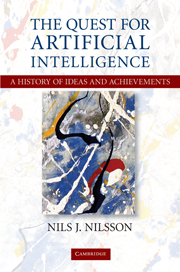Book contents
- Frontmatter
- Contents
- Preface
- PART I BEGINNINGS
- PART II EARLY EXPLORATIONS: 1950S AND 1960S
- PART III EFFLORESCENCE: MID-1960S TO MID-1970S
- 9 Computer Vision
- 10 “Hand-Eye” Research
- 11 Knowledge Representation and Reasoning
- 12 Mobile Robots
- 13 Progress in Natural Language Processing
- 14 Game Playing
- 15 The Dendral Project
- 16 Conferences, Books, and Funding
- PART IV APPLICATIONS AND SPECIALIZATIONS: 1970s TO EARLY 1980s
- PART V “NEW-GENERATION” PROJECT
- PART VI ENTR'ACTE
- PART VII THE GROWING ARMAMENTARIUM: FROM THE 1980s ONWARD
- PART VIII MODERN AI: TODAY AND TOMORROW
- Index
- Plate section
9 - Computer Vision
Published online by Cambridge University Press: 05 August 2013
- Frontmatter
- Contents
- Preface
- PART I BEGINNINGS
- PART II EARLY EXPLORATIONS: 1950S AND 1960S
- PART III EFFLORESCENCE: MID-1960S TO MID-1970S
- 9 Computer Vision
- 10 “Hand-Eye” Research
- 11 Knowledge Representation and Reasoning
- 12 Mobile Robots
- 13 Progress in Natural Language Processing
- 14 Game Playing
- 15 The Dendral Project
- 16 Conferences, Books, and Funding
- PART IV APPLICATIONS AND SPECIALIZATIONS: 1970s TO EARLY 1980s
- PART V “NEW-GENERATION” PROJECT
- PART VI ENTR'ACTE
- PART VII THE GROWING ARMAMENTARIUM: FROM THE 1980s ONWARD
- PART VIII MODERN AI: TODAY AND TOMORROW
- Index
- Plate section
Summary
Sighted humans get much of their information through vision. that part of AI called “computer vision” (or, sometimes, “machine vision”) deals with giving computers this ability. Most computer vision work is based on processing two-dimensional images gathered from a three-dimensional world – images gathered by one or more television cameras, for example. Because the images are two-dimensional projections of a three-dimensional scene, the imaging process loses information. That is, different three-dimensional scenes might produce the same two-dimensional image. Thus, the problem of reconstructing the scene faithfully from an image is impossible in principle.
Yet, people and other animals manage very well in a three-dimensional world. They seem to be able to interpret the two-dimensional images formed on their retinas in a way that gives them reasonably accurate and useful information about their environments.
Stereo vision, using two eyes, helps provide depth information. Computer vision too can use “stereopsis” by employing two or more differently located cameras looking at the same scene. (The same effect can be achieved by having one camera move to different positions.) When two cameras are used, for example, the images formed by them are slightly displaced with respect to each other, and this displacement can be used to calculate distances to various parts of the scene. The computation involves comparing the relative locations in the images that correspond to the objects in the scene for which depth measurements are desired. This “correspondence problem” has been solved in various ways, one of which is to seek high correlations between small areas in one image with small areas in the other.
- Type
- Chapter
- Information
- The Quest for Artificial Intelligence , pp. 125 - 140Publisher: Cambridge University PressPrint publication year: 2009



